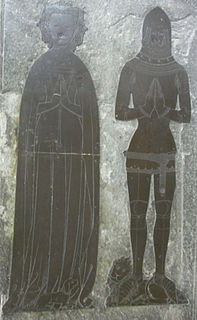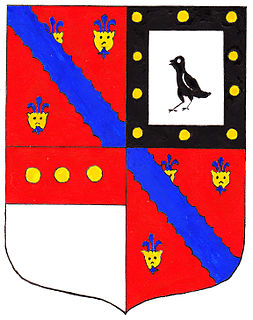Related Research Articles

Braunton is an English village, civil parish, ecclesiastical parish and former manor in Devon. The village is situated 5 miles (8 km) west of Barnstaple. It is one of the largest villages in Devon with a population at the 2011 census of 7,353 people. There are two electoral wards. Their joint population at the above census was 8,218. Within the parish is the fertile, low-lying Braunton Great Field, which adjoins the undulating Braunton Burrows, the Core Area in North Devon Biosphere Reserve, the largest psammosere in England. It confronts the Atlantic Ocean at the west of the parish at the large beach of Saunton Sands, one of the South West's international-standard surfing beaches.

Acklam is a suburb in the Borough of Middlesbrough, North Yorkshire, England. It is believed that the settlement is Anglo-Saxon in origin, the name is Old English for "place at the oak clearings" or "place of oaks".

Dibden is a small village in Hampshire, England, which dates from the Middle Ages. It is dominated by the nearby settlements of Hythe and Dibden Purlieu. It is in the civil parish of Hythe and Dibden. It lies on the eastern edge of the New Forest in a valley, which runs into Southampton Water.

Bramshill House, in Bramshill, northeast Hampshire, England, is one of the largest and most important Jacobean prodigy house mansions in England. It was built in the early 17th century by the 11th Baron Zouche of Harringworth but was partly destroyed by fire a few years later. The design shows the influence of the Italian Renaissance, which became popular in England during the late 16th century. The house was designated a Grade I listed building in 1952.

North Charford is a hamlet in the New Forest district, in Hampshire, England, near the Wiltshire border. Historically the name refers to a manor which is now in the civil parish of Breamore on the west bank of the River Avon.

Sisland is a very small village, manor and parish in the county of Norfolk, England, about a mile west of Loddon. The Parish covers an area of 1.90 km2 (0.73 sq mi) and had a population of 44 in 16 households at the 2001 census.

Bayworth is a hamlet in the civil parish of Sunningwell about 3 miles (5 km) south of Oxford. Bayworth was part of Berkshire until the 1974 boundary changes transferred it to Oxfordshire.
William Rosewell was the Solicitor-General to Queen Elizabeth between 1559 and 1566.

Littleton is a village in the Borough of Spelthorne, approximately 16 mi (26 km) west of central London. Historically part of the county of Middlesex, it was transferred to Surrey in 1965. It is the location of Shepperton Studios.

Snoddington is a small hamlet in Hampshire and close to the border of Wiltshire near to Thruxton Aerodrome and first mentioned in the eleventh century in the Domesday Book.

Thomas de Berkeley, 5th Baron Berkeley, The Magnificent, of Berkeley Castle and of Wotton-under-Edge in Gloucestershire, was an English peer and an admiral. His epithet, and that of each previous and subsequent head of his family, was coined by John Smyth of Nibley (d.1641), steward of the Berkeley estates, the biographer of the family and author of "Lives of the Berkeleys".

Shalden is a village and civil parish in the East Hampshire district of Hampshire, England. It is 2.3 miles (3.7 km) northwest of Alton and 1.9 miles (3.1 km) northeast of Bentworth, just off the A339 road. The parish covers an area of 1,536 acres (622 ha) and has an average elevation of 600 feet (180 m) above sea level. The nearest railway station is Alton, 2.5 miles (4.0 km) southeast of the village. According to the 2011 census, it had a population of 435.
Sir Gilbert Denys of Siston, Gloucestershire, was a soldier, and later an administrator. He was knighted by January 1385, and was twice knight of the shire for Gloucestershire constituency, in 1390 and 1395 and served as Sheriff of Gloucestershire 1393-4. He founded the family which provided more Sheriffs of Gloucestershire than any other.

Sir Philip Courtenay, of Powderham, Devon was the fifth son of Hugh Courtenay, 10th Earl of Devon (1303–1377). He was the founder of the cadet dynasty known as "Courtenay of Powderham", seated at the manor of Powderham, until then a former Bohun manor of little importance, whilst the line descended from his elder brother, the Earls of Devon of the mediaeval era, continued to be seated at Tiverton Castle and Okehampton.

Sir William Denys (1470–1533) of Dyrham, Gloucestershire, was a courtier of King Henry VIII and High Sheriff of Gloucestershire in 1518 and 1526.

Penkridge is a village and parish in Staffordshire with a history stretching back to the Anglo-Saxon period. A religious as well as a commercial centre, it was originally centred on the Collegiate Church of St. Michael and All Angels, a chapel royal and royal peculiar that maintained its independence until the Reformation. Mentioned in Domesday, Penkridge underwent a period of growth from the 13th century, as the Forest Law was loosened, and evolved into a patchwork of manors of greatly varying size and importance, heavily dependent on agriculture. From the 16th century it was increasingly dominated by a single landed gentry family, the Littletons, who ultimately attained the Peerage of the United Kingdom as the Barons Hatherton, and who helped modernise its agriculture and education system. The Industrial Revolution inaugurated a steady improvement in transport and communications that helped shape the modern village. In the second half of the 20th century, Penkridge grew rapidly, evolving into a mainly residential area, while retaining its commercial centre, its links with the countryside and its fine church.

Sir Richard Vernon was an English landowner, MP and speaker of the House of Commons.
Milton Manor is a manor house in the parish of Brading on the Isle of Wight, in England.
The Manor of Dyrham was a former manorial estate in the parish of Dyrham in South Gloucestershire, England.

Sir Andrew Henley, 1st baronet (1622–75), of Bramshill, Hampshire was an English politician and the first of the Henley baronets. He is best remembered for his celebrated quarrel with the future Duke of Bolton, which is recorded in the Diary of Samuel Pepys.
References
 This article incorporates text from this source, which is in the public domain : William Page's History of the County of Hampshire: Volume 4 (1911).
This article incorporates text from this source, which is in the public domain : William Page's History of the County of Hampshire: Volume 4 (1911).